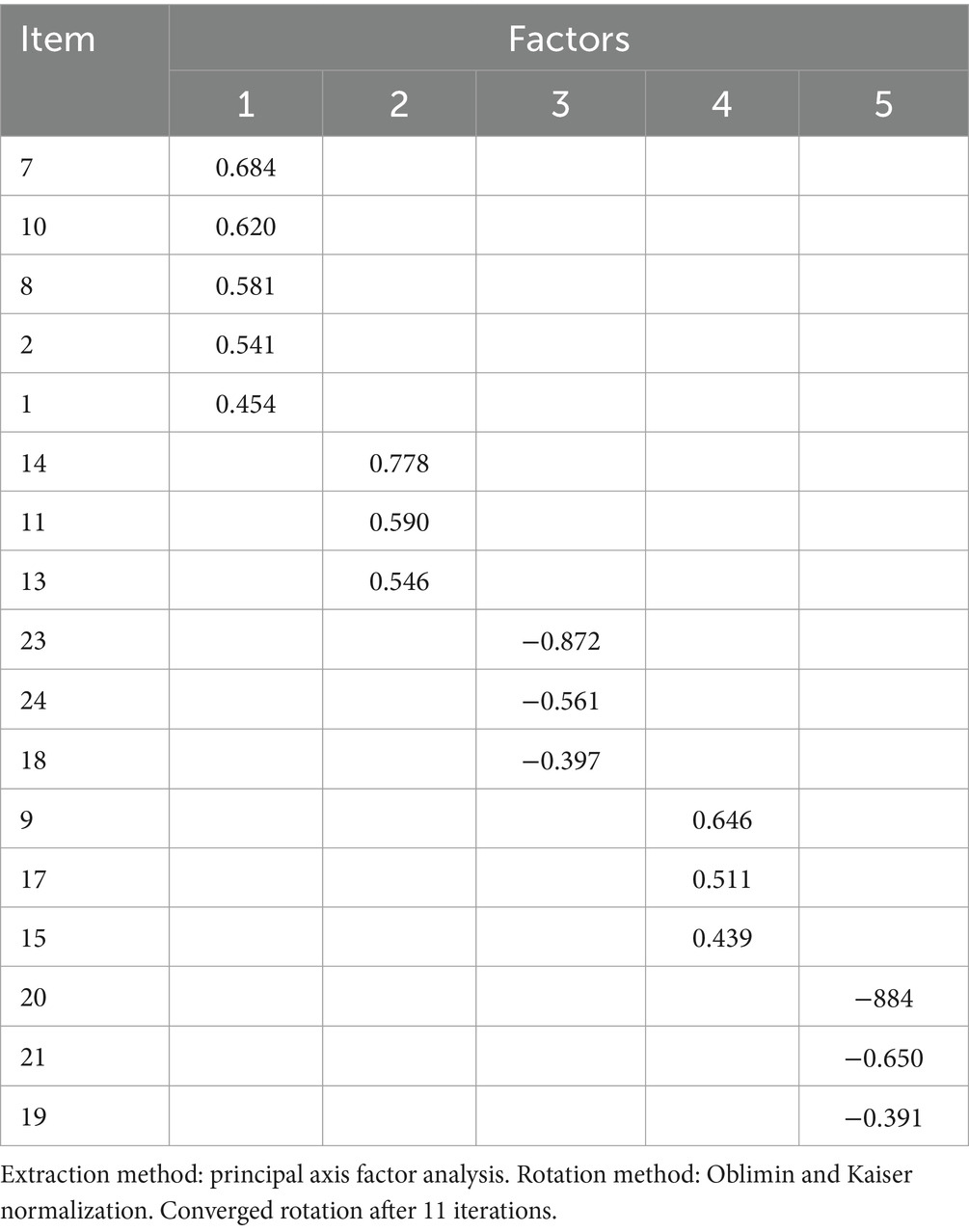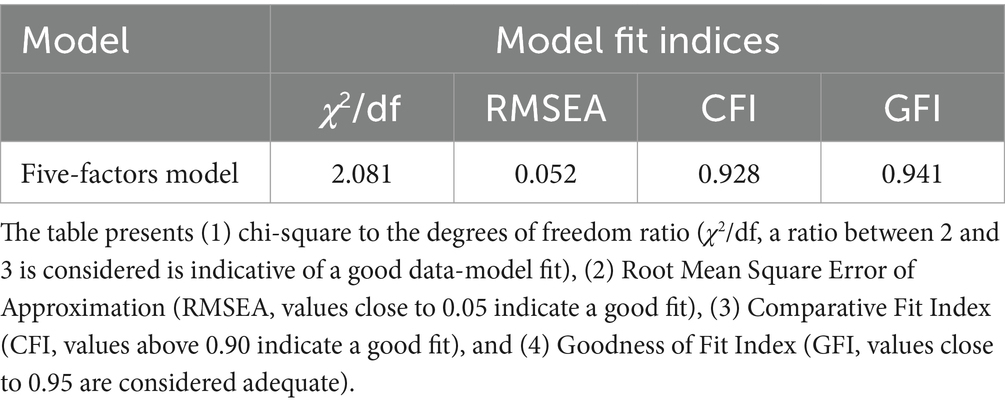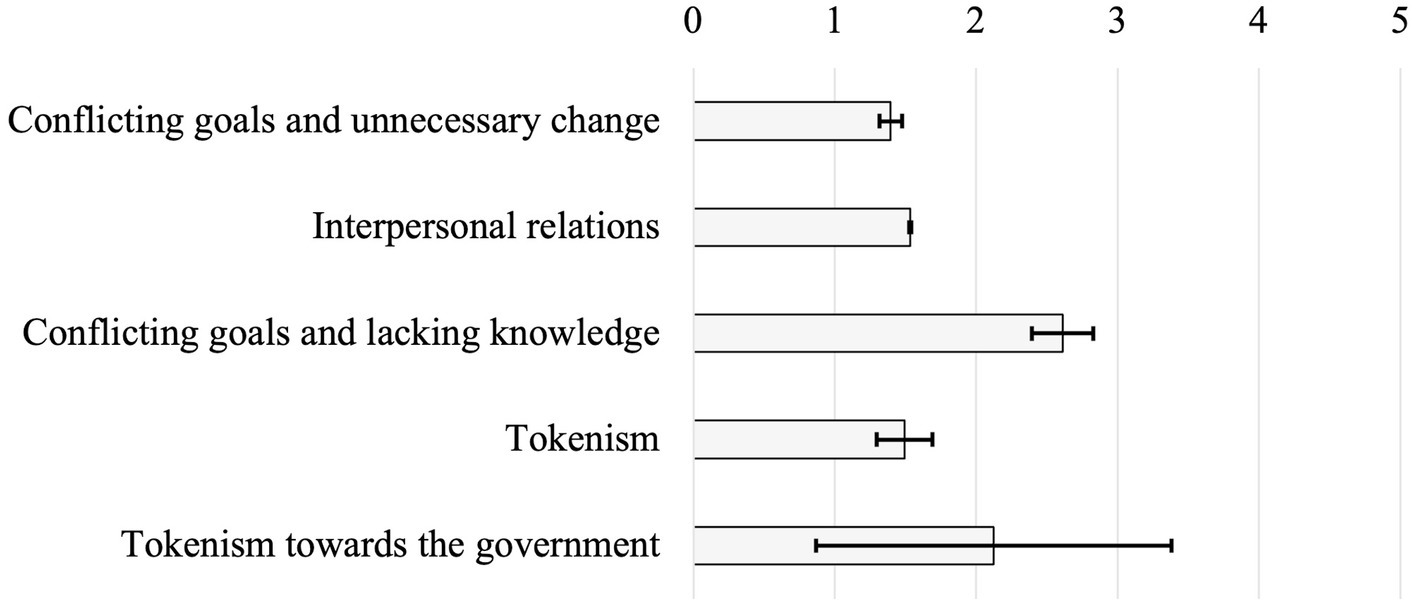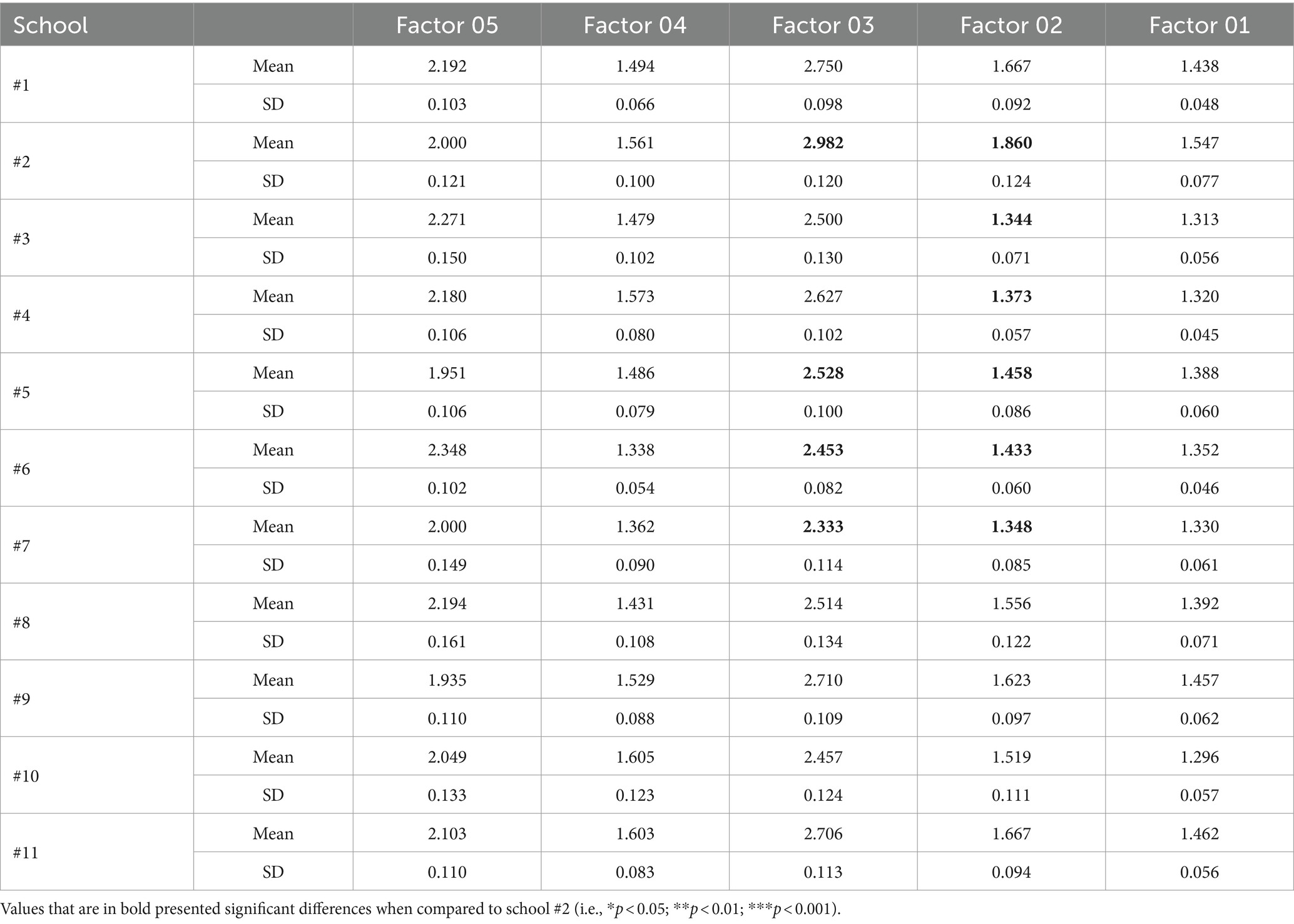- School of Education, University of Brasília, Brasília, Brazil
Dengue is an arboviral infection found in tropical and subtropical regions transmitted by hematophagous mosquitoes from the genus Aedes spp. and responsible for millions of cases every year. Public campaigns and educational curriculum are designed to educate people, including children. However, what has been reported is that many decide not to follow these guidelines, even though they allegedly know what has to be done. To understand this phenomenon, this study aims to identify psychological barriers behind the adoption of pro-environmental behaviors that seek to reduce Aedes aegypti’s population. For that, middle school students participated on two studies responsible for (1) adapting the Dragons of Inaction Psychological Barrier (DIPB) scale to the target group (n = 150) and then (2) testing it on a larger group (n = 449). In the exploratory factor analysis, Bartlett correlation (p < 0.001), Cronbach’s alpha (0.83), and KMO analysis (overall MSA = 0.84) showed that data was suited for factor analysis. Five factors were retained by Kaiser Criterion and scree test (i.e., Conflicting goals and unnecessary changes—α 0.76, Interpersonal relations—α 0.72, Conflicting goals and lacking knowledge—α 0.58, Tokenism—α 0.73, and Tokenism toward the government—α 0.66). After that, the scale was tested across 11 different schools, where students also answered a questionnaire about the mosquito. Results suggested that the factors Conflicting goals and lacking knowledge and Tokenism toward the government presented a higher level of agreement for all students (means: 2.6 and 2.12 out of five, respectively). Those who scored higher in the mosquito’s questionnaire had factors Conflicting goals and unnecessary change and Interpersonal relations inhibited when compared to others (p < 0.05). These results suggests that future educational campaigns should build different actions that focuses on addressing both internal and external factors, creating a mosaic of projects, with different goals, each aiming different environmental challenges.
Introduction
Dengue is an arboviral infection found in tropical and subtropical regions, causing 400 million cases and 22,000 deaths worldwide every year (Hosseini et al., 2018; Roy and Bhattacharjee, 2021). In Brazil, A. aegypti and Dengue reemerged over 40 years ago (Teixeira et al., 2009), and while in 2022 1.393.684 probable cases were identified, more than 5 million cases were reported for the first semester of 2024 already (Brazil, 2023, 2024).
Arboviruses are those transmitted by hematophagous arthropods and, in this case, by mosquitoes from the genus Aedes spp., where Aedes aegypti and Aedes albopictus are the most common ones (Kraemer et al., 2015). The mosquito’s female feeds on the blood from its host to mature its eggs, which are later going to be deposited on stagnant water. It is during the feeding moment that the insect injects its saliva, which may contain the Dengue virus and others (i.e., Chikungunya, Zika and Yellow fever viruses) (Junior et al., 2015; Vu et al., 2017).
In nature, these insects usually use water that accumulates in some plant parts, like in bromeliads, for example. However, in urban environments, they find a larger number of options, like plates of plants, empty bottles, open water tanks, poorly discarded tires and others. These objects can easily accumulate water from the rain and become adequate spots for oviposition.
To reduce the mosquitos’ population, a combination of actions from the government and general public are necessary (i.e., environmental interventions) (Zara et al., 2016). From the population’s perspective, to avoid any stagnant water in their houses and appropriate trash disposal are the most effective interventions. These reduce entomological indicators, involve few resources, and are easy to implement (Tortosa-La Osa et al., 2022).
The set of behaviors necessary for these interventions are called Pro-Environmental Behaviors (PEB’s) (Iglesias et al., 2014; Karp, 1996; Lange and Dewitte, 2019). To achieve this set, multiple variable are taken into consideration, split into personal and context levels of approach (Corral-Verdugo and Pinheiro, 1999; Schultz and Kaiser, 2012), internal and external factors (Kollmuss and Agyeman, 2010) and cultural aspects of societies (Tam and Chan, 2017).
Nevertheless, when considering that PEB’s cannot be imposed, what can be achieved is the establishment of a positive attitude toward a specific behavior, that is built alongside a strong system of values and beliefs (Best and Mayerl, 2013; Corraliza and Berenguer, 2000; Pato and Delabrida, 2019; Pato and Tamayo, 2006). In order to better understand this phenomenon, many articles have discussed it in recent years using a wide variety of groups and scenarios, like celebrities endorsement on the use of single-use plastics (Ho et al., 2022), how policy makers can encourage PEB amongst their target audiences (Lucas et al., 2008), meat consumption (Graves and Roelich, 2021), and others (Grilli and Curtis, 2021; Yuriev et al., 2018).
However, despite some positive results, what is seen in recent literature is a gap between presenting a positive attitude toward PEBs and actually manifesting them (Gaspar, 2013; Kollmuss and Agyeman, 2010; Quimby and Angelique, 2011). These psychological barriers are explained by a number of factors, which have been named Dragons of Inaction (Gifford, 2011).
Most recently, a study tried to develop a scale to assess factors involved in the lack of action toward various environmental problems (Lacroix et al., 2019) [i.e., (1) Change unnecessary, (2) Conflicting goals and aspirations, (3) Interpersonal relations, (4) Lacking knowledge, and (5) Tokenism]. This scale, called the Dragons of Inaction Psychological Barriers’ scale (DIPB scale) has been validated and tested by undergrad students in Canada (Lacroix et al., 2019), United States (Mouchrek et al., 2022) and Colombia (Gutiérrez et al., 2022), but it has not been validated in Brazilian territory or a younger group of people. Factors within a scale are variables that are being tested for a specific barrier.
Regarding A. aegypti, the population is usually instigated by various educational programs accessed over the television and activities in schools, parks, and public spaces. Not only that, but sanitary agents also visit residences to check for possible sites of oviposition and to answer questions by the public. Although educational campaigns have previously shown a positive correlation between knowledge and preventive practices (Brusich et al., 2015; Yasmeen et al., 2015), there is still a group of people who choose not to take part on it (Caregnato et al., 2008; Chiaravalloti Neto, 1997; Chiaravalloti Neto et al., 1998; Chiaravalloti et al., 2002; Claro et al., 2004). At the same time, a more recent review recognizes that educational campaigns are essential to reduce breeding sites and interrupt disease transmission, but questions the quality of evidence, considering a multi modal approach (Bouzid et al., 2016). To propose new insights on how educational campaigns can be more effective to prevent mosquitoes’ proliferation, this study aims to identify possible psychological barriers behind the adoption of pro-environmental behaviors expected to reduce Aedes aegypti’s population.
Materials and methods
This is an exploratory study where two questionnaires were used to create enough data for a quantitative analysis. This article is divided than into two studies, one for validating the Dragons of Inaction Psychological Barriers scale and the second for verifying possible barriers and assimilation of concepts by students from different schools.
Data collection and participants
For both studies, 11 public schools from the city of Volta Redonda, Brazil, all urban, were visited. Then, seventh grade students (age’s mean 12.52 years old, SD = 0.866) were selected to answer the questionnaires during the year of 2023. The city is located in the inner part of Rio de Janeiro’s state, southeast of the country, and many educational campaigns have been made over the last years to educate its population on the expected PEB’s to control the mosquito. These campaigns are mostly run through the radio and television, with specific educational actions also happening in city events, many targeted to children, and by public environmental agents that visit houses and other facilities to check for contaminated spots.
School’s infrastructure varied depending on the city’s regions, but a correlation between it and dengue’s knowledge was not expected, considering that the majority of educational campaigns on this topic happens outside the school environment. Nevertheless, it is part of the 7th grade Brazilian science curriculum to discuss health indicators in a community, considering access to basic sanitation and common illness, such as Dengue fever. Because of these aspects, it is expected that children around that age and grade already have the knowledge expected to inhibit mosquitoes’ proliferation.
Thus, after the initial contact with each school’s principal, all schools were visited to explain what the research was about and invite students to participate. They were handed a form to be sent to their parents, explaining what the questionnaires were about, research’s relevance, and contact information. Only students that turned in those documents, signed by one of their parents or legal caretakers, and agreed to participate in this research could answer the questionnaires on the following meeting. This study was approved by the human research ethics committee of the University of Brasilia.
On the agreed day, groups of 10 students were asked to come to the school’s library, where the questionnaires were handed, and instructions were given. After finishing answering it, they were sent back to class. The whole process for each group lasted 30 min approximately.
On the first study, 150 students (81 male and 69 female) were selected to answer the 22-items DIPB scale. These results were used for an Exploratory factor analysis (EFA), and, after making the required adjustments, the DIPB scale and Dengue’s questionnaire were applied to a new set of students following the same criteria (n = 449, 213 males and 236 females) (Study 2). To present the results, items were later translated back to the English language again.
Dragons of inaction psychological barriers scale’s adaptation
Initially, the DIPB scale developed by Lacroix et al. (2019) had to be adapted to the Brazilian perspective. For that, first, three different English teachers translated each of the 22 items from the original scale. Secondly, items were adapted to accommodate to the literacy expected from kids at this age group (12–13 years old). To specify the relatedness to each of the items, a Likert scale-using emojis was used, based on a five point system (Bouranta et al., 2009; Lapa, 2019; Preston and Colman, 2000).
Dengue’s questionnaire
This questionnaire contained four questions, where each covered one of the major skills expected by the population to prevent mosquito’s reproduction and proliferation. They are: (Item 01) to recognize the different stages of the insect’s life cycle (egg, larvae, pupae, and adult), (Item 02) to associate its different stages to environmental factors (i.e., stagnant water), (Item 03) to recognize different diseases transmitted by the mosquito, and (Item 04) to identify the main prophylactic measures to reduce mosquito’s population.
On item 01, students would have to number the correct sequence that represents the order of stages for the insect’s life cycle (i.e., egg, larvae, pupae, and adult). On items 02, 03, and 04, students would be presented nine different options, where some of them were correct while others were wrong, having to identify, by marking an “X,” the correct ones.
For items 02, 03, and 04, in order to identify false positive results (i.e., students randomly guessing multiple items), options within the items that were marked incorrectly nullified a correct marking. The lowest score for each of those items would be zero, and students that scored maximum points did that by selecting only correct options.
In the end, each student would be graded from 0 to a 100 (i.e., 25 points from each question) based on the answers given. The set of results would then be divided into quartiles for data comparison with the DIPB scale.
Results
Study 1—Exploratory Factor Analysis
Principal axis factor analysis with oblimin rotation was used to extract factors. Bartlett correlation test (p < 0.001) and KMO analysis (overall MSA = 0.84; meritorious) showed that data was suited for factor analysis and α-Cronbach was 0.85. Items that showed low communalities (lower than 0.30) and/or were loaded in more than one factor were eliminated. The Kaiser Criterion (i.e., eigenvalue >1) and scree test suggested retaining five factors, explaining 62.66% of the variation. The results for the EFA proposed the removal of five items and reorganized the five factors (Table 1). From the remaining items, two of them (items 1 and 17) had low communalities but were retained due to its loadings within their correspondent factors.
The new factor distribution rearranged the 17 items into five different factors, where factor 01 contained five items and other factors three items (Table 2; Figure 1). Names of each factor were altered to accommodate the proposed changes.
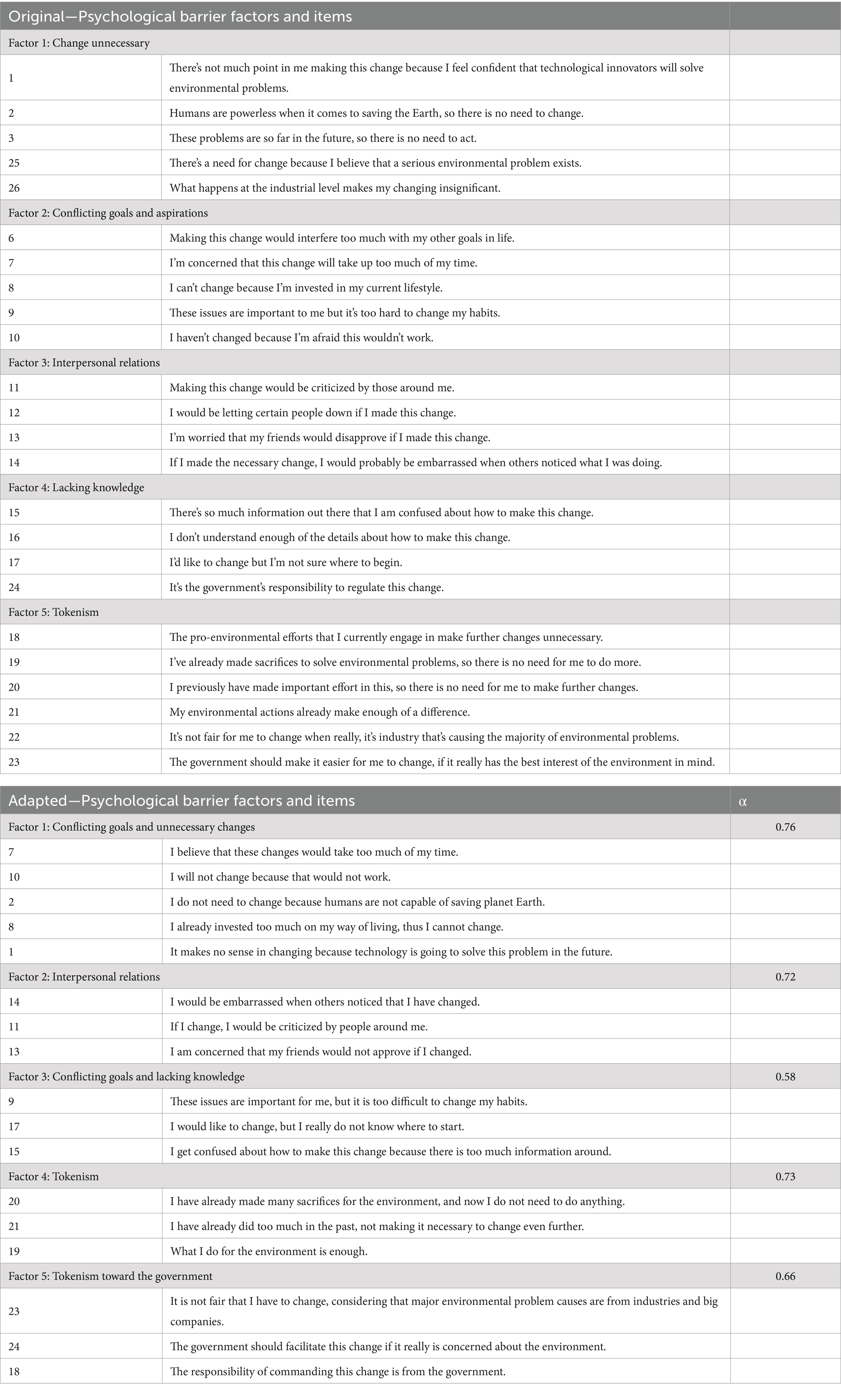
Table 2. Original DIPB scale and its adapted version containing Cronbach’s alpha (α) for its factors.
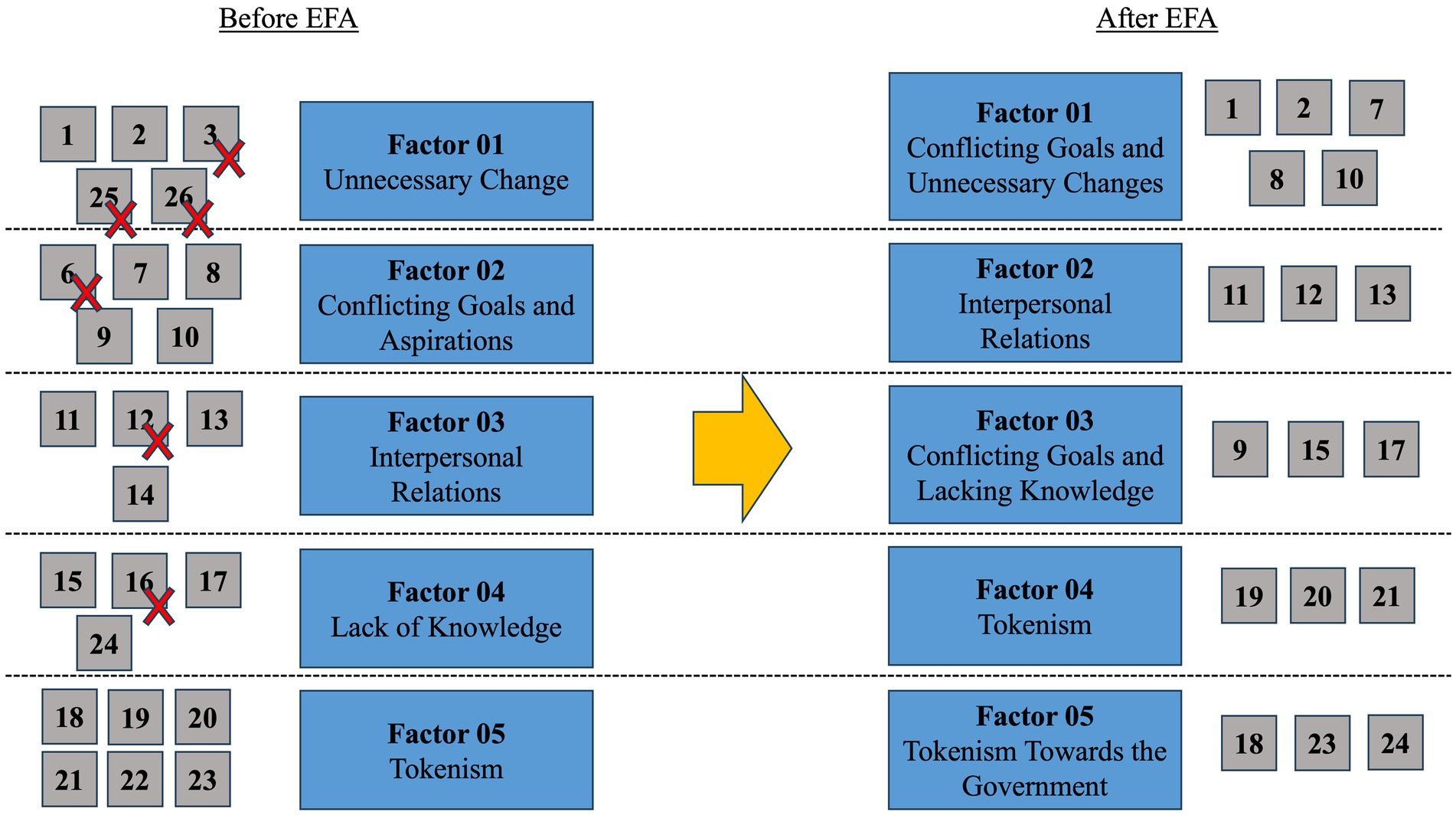
Figure 1. New arrangement for the DIPB scale after exploratory factor analysis (EFA). On the left, grey boxes represent items within each factor in the original DIPB scale, while on the right is shown the new configuration after EFA. Blue boxes represent factor’s previous names (left) and adjusted names (right). The red crosses show items that were eliminated during EFA.
Study 2—Dengue’s questionnaire test results
In total, the mean score was 68.95 and 70.8 median. Minimum score was 25 (n = 1) while maximum score was 100 (n = 10). Scores were grouped within quartiles, where first quartile was 58.3 (n = 109), second quartile was 70.8 (n = 121), third quartile was 79.10 (n = 128), and fourth quartile (n = 91) (Figure 2).
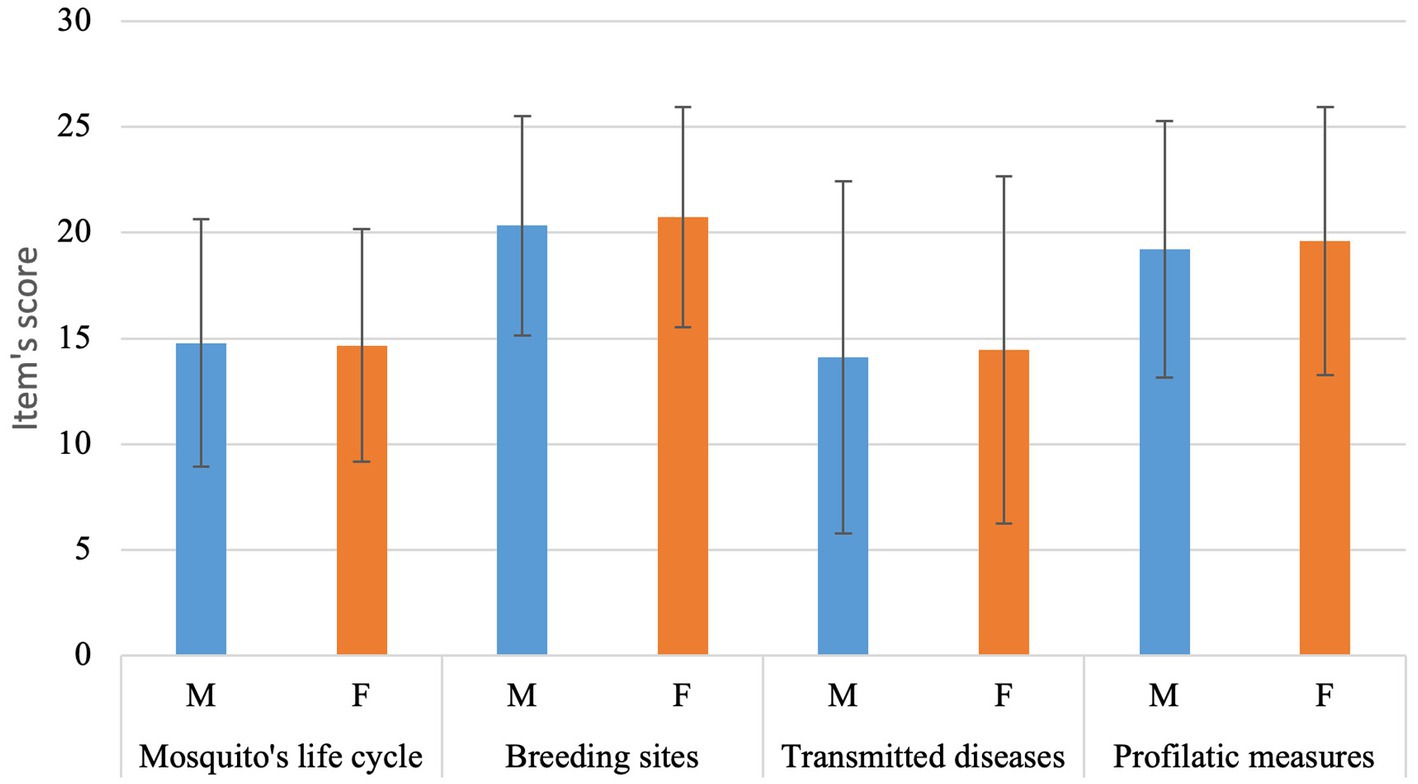
Figure 2. Average score for each of the four items in the Dengue fever’s test split into male (M) and female (F) (i.e., separated by the topics each referred to).
Item 01’s average score was 14.72 and 94 students achieved maximum score (20.93%). Although students were able to easily identify an adult mosquito from an egg, they struggled to differentiate larvae and pupae stages, thus reducing the item’s score (n = 337, 75.05%).
Item 02’s average score was 20.54 and 221 students achieved maximum score (49.22%). Items correctly related to mosquito’s reproduction that were most identified by students were leaving the water tank open (n = 435, 96.88%), plant vases (n = 388, 86.41%), disposed tires (n = 376, 83.74%), and rubbish incorrectly disposed (n = 337, 75.05%). At the same time, some actions that are not related to the mosquito were also mentioned as to be possibly related to it, like leaving the water tank closed (n = 32, 7.12%), rats and mice (n = 27, 6.01%), sneezing (n = 15, 3.34%), and holding hands (n = 6, 1.33%).
Item 03’s average score was 14.28 and 111 students achieved maximum score (24.72%). While most students were able to identify Zika (n = 352, 78.39%) and Chikungunya (n = 360, 80.17%) as possible diseases to be transmitted by Aedes aegypti, a smaller number was able to identify Yellow fever (n = 276, 61.46%). At the same time, other diseases, not related to Aedes aegypti were also mentioned as to be possibly transmitted by the mosquito, as in the flu (n = 149, 33.18%), AIDS (n = 60, 13.36%), COVID (n = 17, 3.78%), tetanus (n = 16, 3.56%), and diabetes (n = 10, 2.22%).
Item 04’s average score was 19.39 and 189 students achieved maximum score (42.09%). While most students were able to identify the importance of leaving the water tank closed to prevent mosquitos laying eggs (n = 432, 96.21%), other options were also mentioned, like avoiding water accumulation (n = 402, 89.53%), using sand on water vases (n = 327, 72.82%), and proper trash disposal (n = 298, 66.36%). At the same time, some behaviors that are not related to prevent mosquito’s reproduction were also selected by students, like getting in contact with rusted objects (n = 31, 6.9%), wearing a mask (n = 23, 5.12%), avoid hugging people (n = 15, 3.34%), sugar consumption (n = 11, 2.44%), and physical activities (n = 4, 0.8%).
There was no significant difference between schools on the total result (Kruskal-wallis, p = 0.9513). When evaluating items separately, no difference could be observed between different schools as well (item 01 p = 0.3266, item 02 p = 0.729, item 03 p = 0.4692, item 04 p = 0.8303). The total result also did not differ between genders (Kruskal-Wallis, p = 0.2614).
Study 2—Confirmatory Factor Analysis (CFA)
Confirmatory factor analysis was conducted to verify if items were consistent to its factors. Several indices were used to evaluate model fit (Table 3). Factorial loadings indicate that most variables have a strong association with its respective factors, while correlation between factors suggest a moderate relation and a good distinction between them (Figure 3).
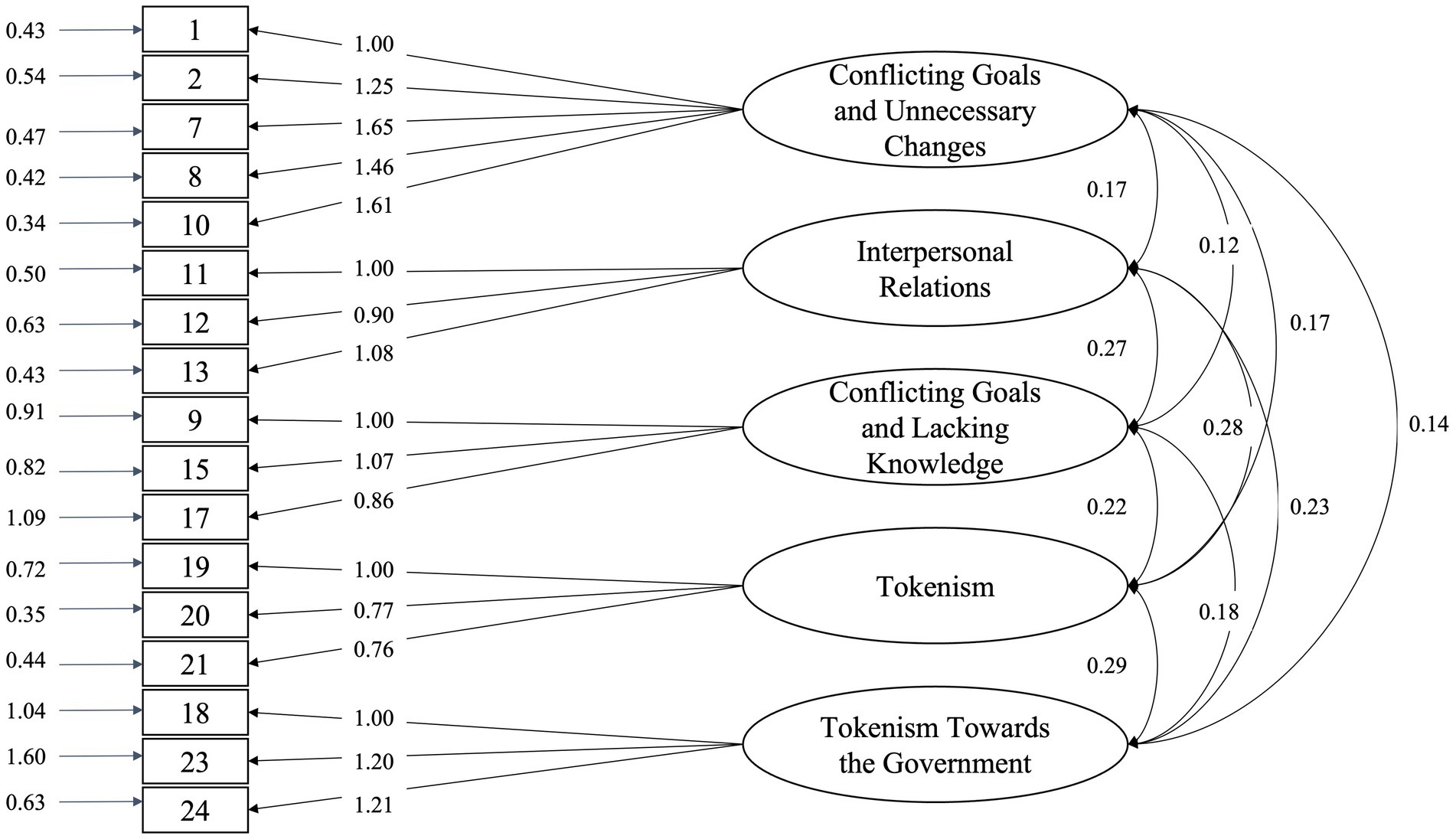
Figure 3. Five-factor model after item removal (n = 449). Arrows pointing from factors to items show factorial loadings, while arrows between factors show correlation, and arrows to the left, pointing to items show their error terms.
The total data collected by the DIPB scale initially pointed those items from factors 3 and 5 showed a higher level of agreement by students (Figure 4).
This pattern was maintained when analyzing the categories individually (i.e., schools, gender, and Dengue’s test result), with significant differences being presented below.
Data was initially split into four categories based on Dengue’s test results (i.e., low score, medium score, high score, and top-high score). Students with a low or medium score on the Dengue’s test presented a higher level of agreement for factors 1 and 2 (Table 4).
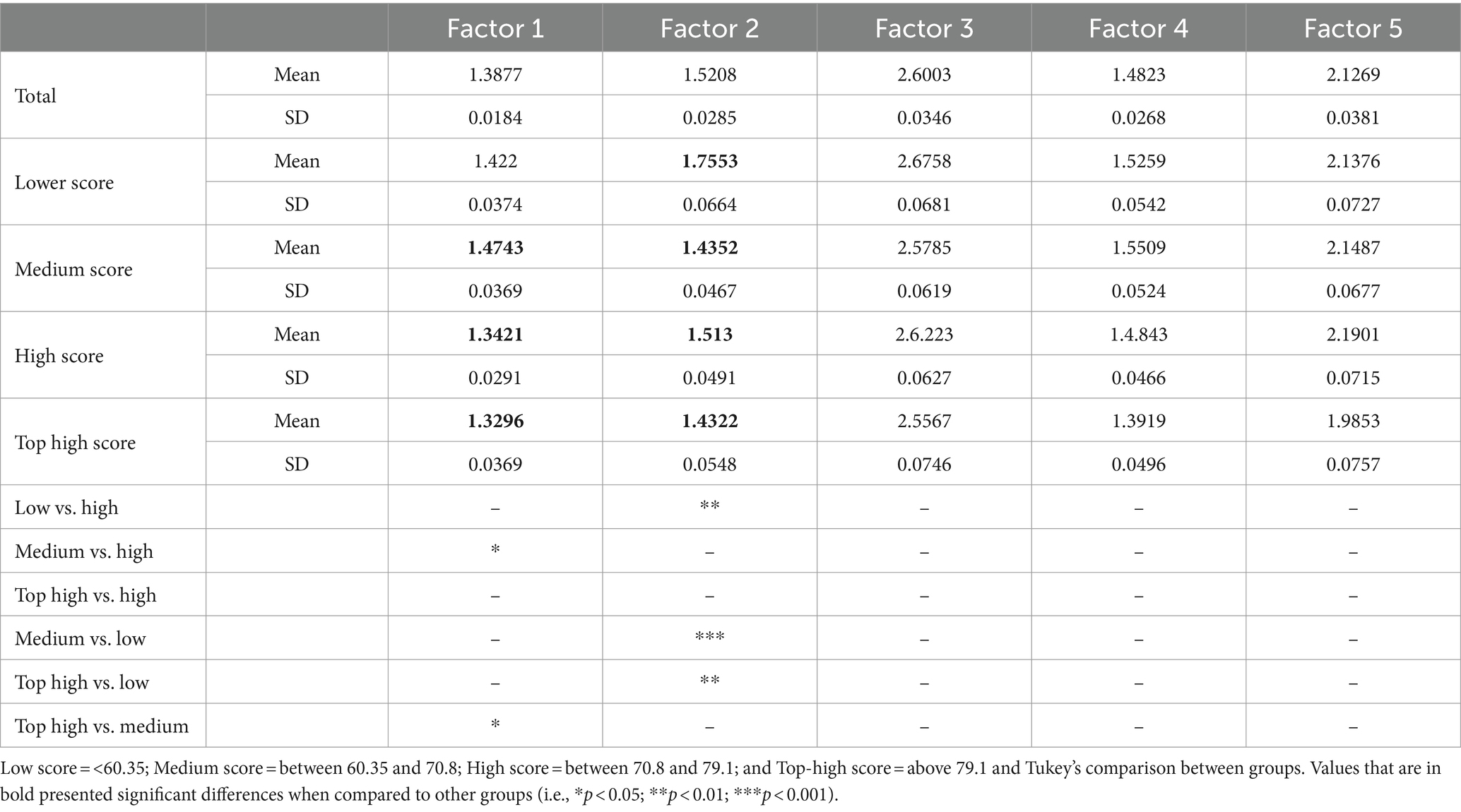
Table 4. Means and standard deviation (SD) of agreement for each factor based on Dengue’s test results.
There was no significant difference between male and female answers, with a subtle tendency for factor 4 (p = 0.0664). Inside this factor, item 19 showed significant difference (p-value: 0.0464, male mean: 1.8984, male SD: 0.0829, female mean 1.6857, female SD: 0.0677), item 20 and 21 showed no significant difference.
Comparison between schools showed significant difference for factors 2 and 3 between school number two when compared to school number three (factor 02: **, factor 03), four (factor 02: **), five (factor 02: *), six (factor 02: **, factor 03: **), and seven (factor 02: *, factor 03: *) (Table 5).
For factors three, four and five, items 17, 19, and 24 were analyzed separately, due to a higher level of agreement when compared to other items within its own factor. Each of these items showed significant difference (p < 0.001) when compared to the other two.
Discussion
Study 1—Exploratory Factor Analysis
For the EFA, the present study identified a rearrange of the items and elimination of five of them. This variation may be explained by three different reasons. First, previous studies that validated the DIPB scale used a sample of undergraduate students, while here respondent’s age mean was 12 years old. This may affect how they interpret the items and connect to them (Boateng et al., 2018; Chwalow, 1995). Secondly, how people relate to the Aedes aegypti and Dengue fever situation is something quite specific for the countries that need to address this issue (Gubler and Clark, 1996). Third, different languages may not encapsulate the complete original meaning of the sentence, in which some subtle differences may affect the final interpretation of the item (Mager et al., 2018; Malá, 2013; Xian, 2008). Thus, although the DIPB scale was originally developed to be used for different ecological contexts, some adaptations may be needed depending on the target group and ecological context that is being analyzed.
Study 2—Dengue fever test results
Many papers have been made trying to propose new approaches toward environmental education actions to fight the mosquito (Espinoza-Gómez et al., 2002; Fernandes et al., 2023; Lloyd et al., 1994).
By the answers given on the test, students showed that they are able to recognize situations and actions that are related to mosquito’s reproduction. The obtained data confirms what was expected by literature, where students understand what are the basic underlying mechanisms behind Aedes aegypti’s reproduction and how to stop it (Cruz and Santana, 2017; Silva et al., 2018). No significant difference was observed between schools, suggesting that the environmental actions that are being taken to educate the population are distributed homogenously.
Although these actions may present positive results, they are still not enough to control mosquito’s proliferation (de Souza et al., 2021). One key aspect that may justify this scenario and has been perceived in recent literature is the conflict between people’s and government’s responsibilities (lack of maintenance of public spaces by the government and lack of management on local dumpsters, for example) (Chiaravalloti et al., 2002; Donalisio et al., 2001; Heymann and Dar, 2014; de Oliveira and Lima, 2013; Rangel-S, 2008; Reis et al., 2013).
The two items that presented the lowest score were Items 01 and 03. The main reason for the first one was that students were not able to differentiate larval and pupal stages. Even though this reduced the item’s mean, it is hypothesized that it would not represent a meaningful difference on how people act to prevent mosquito’s reproduction. Mainly because both stages, larvae and pupae, share the same habitat (i.e., stagnant water).
Regarding Item 03, many students believe that the mosquito may transmit diseases like the flu and AIDS. This information may be relevant for designing future educational campaigns, both for preventing Aedes aegypti’s reproduction and Sexually Transmitted Infections (STI’s).
Items 02 and 04, related to the prophylactic measures necessary to reduce mosquito’s population and identifying areas where females lay their eggs presented the highest scores. This suggests that the educational actions taken by the government and schools are capable of addressing these topics to a younger audience.
Study 2—DIPB’s results
Based on the DIPB’s scale, results suggest that current educational campaigns seem to be unable to address all analyzed barriers. Students that scored higher on Dengue’s test seemed to present less barriers toward adopting PEB for factors 01 and 02 (i.e., Conflicting goals and unnecessary changes and Interpersonal relations), but no significant difference could be observed for the other factors. Thus, teaching about the mosquito’s life cycle and what has to be done to prevent its proliferation (e.g., avoiding the accumulation of clean water in multiple spaces, like flower plates, vases, bottles, roof gutter, and garbage disposal) seems to not be enough to possibly change the behavior of some participants, considering that some psychological barriers are not being considered.
Overcoming these barriers seem to be the greatest challenge faced nowadays. The K&A model (Kollmuss and Agyeman, 2010) was created to identify internal (i.e., Personality traits and value system) and external factors (i.e., Infrastructure, Political, Social, and Cultural factors, and Economic situation) that may impose barriers to PEB. This model is being tested in recent years (Graves and Roelich, 2021) and some of these factors could justify the barriers identified in this study.
Factors 03 and 05 (i.e., Conflicting goals and lacking knowledge and Tokenism toward the government) presented the highest level of agreement by students overall. The items that presented the higher level of agreement were 17 (factor 3, mean: 3.0098, I would like to change, but I really do not know where to start) and 24 (factor 5, mean: 2.6683, the government should facilitate this change if it really is concerned about the environment). Considering the presented results, and what has been described in previous papers, it seems to be imperative that educational programs continue to address and reinforce PEB by the population, but also facilitates the communication to the local government, making it clear the responsibilities between internal and external factors. It is proposed that this communication needs to address public spaces management and general complaints.
Wu et al. (2023), states the relevance of local governments in regulating and empowering the population, mainly by resource mobilization and political processes for residents to manifest desired PEB. Other studies have also identified how the role of perceived government is able to influence PEB (Berglund and Matti, 2006; Lavergne et al., 2009).
School # 2 presented higher values for factor 2 and 3, presenting a significant difference when compared to other schools, even though there was no significant difference this particular institution and other schools for the Dengue’s questionnaire. The school is located in the biggest city’s neighborhood, attending students from a variety of regions. This result may be explained by the access those students have to educational campaigns from the government and media, but more studies are necessary to understand this variation. To better understand it, a multi-variable analysis is suggested, where aspects like (1) government’s presence in the region (i.e., parks maintenance and waste disposal), (2) frequency of sanitary agents visits, and (3) socioeconomically aspects (Corral-Verdugo and Pinheiro, 1999; de Souza et al., 2021) are suggested and may be responsible for eliciting these psychological barriers.
This pattern repeated itself even with students that scored high on Dengue’s test, showing that they understand what is necessary to inhibit mosquito’s reproduction, but maybe do not feel in the position to take action. Therefore, environmental education programs and actions need to address these barriers to encourage students to take action to protect the environment and prevent the proliferation of Dengue mosquitoes.
Suggestions for future environmental education projects
Environmental education projects and actions developed in the last decades have distanced themselves from a conservationist point of view to a more critical perspective. In a research on developed papers from between 2003 and 2007, (Pato et al., 2009), identified that a socioenvironmental approach, that recognizes political and cultural aspects as part of a new epistemological perspective is notable. Thus, creating new to ways to build positive connections between the population and natural environmental seems to be the current tendency (Ardoin et al., 2020; Li et al., 2024; San Jose and Nelson, 2017).
When considered the actions toward inhibiting Dengue mosquitoes’ reproduction, a practical approach is, in many cases, adopted (Luz et al., 2024; Rosa et al., 2020). One of the reasons for that is the large scale in which this subject is engaged, through the television, radio, educational campaigns, and others. These procedures repeat themselves in different places, with almost no change on how they occur.
In these strategies, the participant, a mere receptor of information, must replicate the instructions in their houses or region where they live. The change on how they relate to the environment, government, and how information and experiences are exchanged is mostly disconsidered. It is believed that one of the main reasons for that is the use of indicators to measure the efficiency of these campaigns. The term efficiency is used on this study because of the relation between educational campaigns and reduction of cases reported or breeding sites identified by public agents (Arantes et al., 2023; Caregnato et al., 2008; Gonçalves et al., 2023; Luz et al., 2024; Sulistyawati, 2024).
Thus, it is initially suggested a segmentation between the different goals an environmental education project or action on that matter might have. While some actions may focus in informing about the mosquito, symptoms and how to prevent its proliferation (dos Santos et al., 2023), others must focus on creating more powerful connections between the population, environment and government (Busato et al., 2024; Martín et al., 2024; de Oliveira and Lima, 2013; de Souza Pinto et al., 2013). By doing that, and clearly establishing the responsibilities between the many responsible agents of that phenomenon, it is expected to diminish the barriers identified in the studies here presented.
This seems to be general consensus of what has already been described in recent literature (Costa and dos Anjos Carneiro-Leão, 2021; dos Santos and Vieira, 2023) A recently published review on five decades of Dengue’s prevention and control in Singapore showed four key features that were responsible for significantly reducing the mosquito index, where coordinated inter-sectoral cooperation is one of them (Ho et al., 2023).
To inform the population about individual, collective, and governmental responsibilities, creating ways to connect those points may be an important step in reducing the barriers here presented. However, not only that, but also to find ways to create positive connections between different segments of society and nature, strengthening values and beliefs that are closely related to PEB’s is essential to create long lasting changes (de Lima and Pato, 2021; Portus et al., 2024; Tucholska et al., 2024; Goulart et al., 2016), points out that the lack of information, absence of environmental education campaigns, rapid proliferation of the mosquito, and lack of governmental preventive actions are among the main factors that weakens public policy, even in regions with adequate budgets to fight the disease. It is then perceived the environmental education programs cannot be reduced to isolated actions of informing the population, but something that creates a mosaic of actions and projects, with different goals, capable of aiming internal and external factors for various environmental challenges.
Conclusion
This work aimed to identify possible psychological barriers behind the adoption of pro-environmental behaviors expected to reduce Aedes aegypti’s population. For that, a scale for psychological barriers was initially validated for Brazilian children, and then tested across multiple variables. This is the first study to assess psychological barriers toward A. aegypti using a quantitative methodology. Thus, considering the nature of an exploratory study and subject’s novelty, some considerations and propositions are made for future investigations. For future research, understanding if different target groups (i.e., age group, geographical location, education levels and others) present similar barriers, and comparing different strategies of environmental education projects and actions seems to be an important step to validate possible trends in psychological barriers toward PEB’s on that matter.
The DIPB scale had to be adjusted after EFA and some factors were rearranged. It is suggested that new adaptations may be needed to accommodate the subtle variables that are present in different geographical regions, linguistic aspects, and target group (i.e., age, education level, and economical background). Also, regional differences and the impact caused by A. aegypti infestation and its correlated diseases may affect the barriers observed in different regions.
Dengue’s questionnaire showed that students know what has to be done to prevent mosquito’s proliferation, and how water is connected to its life cycle. However, the diseases that may be transmitted by it, besides Dengue fever, still seem to be confusing.
Students that scored lower in Dengue’s questionnaire presented more barriers when compared to those who scored higher for factors 01 (Conflicting goals and unnecessary changes) and 02 (Interpersonal relations). Educational programs seem to be effective to reduce these barriers, even though some are still present.
On the adapted DIPB scale, students presented a higher agreement on items 17 (I would like to change, but really do not know where to start), 19 (What I do for the environment is enough), and 24 (The government should facilitate this change if it really is concerned about the environment). These results suggests that future educational campaigns should build different actions that focuses on addressing both internal and external factors, creating a mosaic of projects, with different goals, each aiming different environmental challenges.
Data availability statement
The raw data supporting the conclusions of this article will be made available by the authors, without undue reservation.
Ethics statement
The studies involving humans were approved by the Comitê de Ética em Pesquisa em Ciências Humanas e Sociais (CEP/CHS) of Universidade de Brasília, C.A.A.E., nº 66395022.8.0000.5540. The studies were conducted in accordance with the local legislation and institutional requirements. Written informed consent for participation in this study was provided by the participants' legal guardians/next of kin.
Author contributions
PS: Writing – review & editing, Writing – original draft, Investigation, Formal analysis, Conceptualization. LL: Writing – review & editing, Validation, Supervision, Software, Methodology, Formal analysis. CL: Writing – review & editing, Supervision, Project administration, Conceptualization.
Funding
The author(s) declare that no financial support was received for the research, authorship, and/or publication of this article.
Conflict of interest
The authors declare that the research was conducted in the absence of any commercial or financial relationships that could be construed as a potential conflict of interest.
Publisher’s note
All claims expressed in this article are solely those of the authors and do not necessarily represent those of their affiliated organizations, or those of the publisher, the editors and the reviewers. Any product that may be evaluated in this article, or claim that may be made by its manufacturer, is not guaranteed or endorsed by the publisher.
References
Arantes, A. P. F., da Silva, L. M., and da Silva, L. C. (2023). Projeto “Xô Dengue”: iniciativa de educação ambiental em um colégio da rede pública de ensino do estado de Goiás. Rebena Rev Brasileira Ensino Aprendizagem 5, 69–78.
Ardoin, N. M., Bowers, A. W., and Gaillard, E. (2020). Environmental education outcomes for conservation: a systematic review. Biol. Conserv. 241:108224. doi: 10.1016/j.biocon.2019.108224
Berglund, C., and Matti, S. (2006). Citizen and consumer: the dual role of individuals in environmental policy. Environ. Politics 15, 550–571. doi: 10.1080/09644010600785176
Best, H., and Mayerl, J. (2013). Values, beliefs, attitudes: an empirical study on the structure of environmental concern and recycling participation. Soc. Sci. Q. 94, 691–714. doi: 10.1111/ssqu.12010
Boateng, G. O., Neilands, T. B., Frongillo, E. A., Melgar-Quiñonez, H. R., and Young, S. L. (2018). Best practices for developing and validating scales for health, social, and behavioral research: a primer. Front. Public Health 6:149. doi: 10.3389/fpubh.2018.00149
Bouranta, N., Chitiris, L., and Paravantis, J. (2009). The relationship between internal and external service quality. Int. J. Contemp. Hosp. Manag. 21, 275–293. doi: 10.1108/09596110910948297
Bouzid, M., Brainard, J., Hooper, L., and Hunter, P. R. (2016). Public health interventions for Aedes control in the time of Zikavirus– a meta-review on effectiveness of vector control strategies. PLoS Negl. Trop. Dis. 10:e0005176. doi: 10.1371/journal.pntd.0005176
Brazil (2023). Situação Epidemiológica—Mosquito da Dengue [Federal website]. Ministério da Saúde. Available at: https://www.gov.br/saude/pt-br/assuntos/saude-de-a-a-z/d/dengue/situacao-epidemiologica (Accessed October 30, 2023).
Brazil (2024). Notícia oficial sobre a Dengue [Governo Federal]. Ministério da Saúde. Available at: https://www.gov.br/saude/pt-br/assuntos/noticias/2024/marco/se-nao-houver-uniao-nao-havera-saude-declara-ministra-nisia-no-dia-d-contra-a-dengue (Accessed March 12, 2024).
Brusich, M., Grieco, J., Penney, N., Tisgratog, R., Ritthison, W., Chareonviriyaphap, T., et al. (2015). Targeting educational campaigns for prevention of malaria and dengue fever: an assessment in Thailand. Parasit. Vectors 8:43. doi: 10.1186/s13071-015-0653-4
Busato, M. A., Schabat, F. M., and Lutinski, J. A. (2024). Educação em Saúde Ambiental e Percepção de Gestores No Controle Populacional Do Mosquito Aedes Aegypti Em Santa Catarina.
Caregnato, F. F., de Fetzer, L. O., Weber, M. A., and Guerra, T. (2008). Educação Ambiental como estratégia de prevenção a dengue no bairro do Arquipélago, Porto Alegre, RS, Brasil. Rev. Bras. Biociências 6:2.
Chiaravalloti, V. B., de Morais, M. S., Chiaravalloti Neto, F., Conversani, D. T., Fiorin, A. M., Barbosa, A. A. C., et al. (2002). Avaliação sobre a adesão às práticas preventivas do dengue: O caso de Catanduva, São Paulo, Brasil. Cad. Saude Publica 18, 1321–1329. doi: 10.1590/S0102-311X2002000500025
Chiaravalloti Neto, F. (1997). Conhecimentos da população sobre dengue, seus vetores e medidas de controle em São José do Rio Preto, São Paulo. Cad. Saude Publica 13, 447–453. doi: 10.1590/S0102-311X1997000300020
Chiaravalloti Neto, F., de Moraes, M. S., and Fernandes, M. A. (1998). Avaliação dos resultados de atividades de incentivo à participação da comunidade no controle da dengue em um bairro periférico do Município de São José do Rio Preto, São Paulo, e da relação entre conhecimentos e práticas desta população. Cad. Saude Publica 14, S101–S109. doi: 10.1590/S0102-311X1998000600009
Chwalow, A. J. (1995). Cross-cultural validation of existing quality of life scales. Patient Educ. Couns. 26, 313–318. doi: 10.1016/0738-3991(95)00767-T
Claro, L. B. L., Tomassini, H. C. B., and Rosa, M. L. G. (2004). Prevenção e controle do dengue: Uma revisão de estudos sobre conhecimentos, crenças e práticas da população. Cad. Saude Publica 20, 1447–1457. doi: 10.1590/S0102-311X2004000600002
Corraliza, J. A., and Berenguer, J. (2000). Environmental values, beliefs, and actions: a situational approach. Environ. Behav. 32, 832–848. doi: 10.1177/00139160021972829
Corral-Verdugo, V., and Pinheiro, J. Q. (1999). Condições para o estudo do comportamento pró-ambiental. Estudos Psicol. 4, 7–22. doi: 10.1590/S1413-294X1999000100002
Costa, J. S., and dos Anjos Carneiro-Leão, A. M. (2021). Campanhas sanitárias como instrumentos da educação em saúde no Brasil: Algumas reflexões para uma educação popular em saúde. Rev. Sustinere 9, 333–351. doi: 10.12957/sustinere.2021.49818
Cruz, A. M. J., and Santana, A. R. (2017). A Educação Ambiental Como Estratégia De Combate AoAedes AEGYPTI.
de Lima, V. F., and Pato, C. (2021). Educação Ambiental: aspectos que dificultam o engajamento docente em escolas públicas do Distrito Federal. Educar Rev. 37:e78223. doi: 10.1590/0104-4060.78223
de Oliveira, J. C., and Lima, S. C. (2013). Mobilização comunitária e vigilância em saúde no controle de vetores, estratégias da promoção da saúde: conquistas e desafios. Rev. Educ. Popular 12:1. doi: 10.14393/REP-2013-23029
de Souza, T. G. B., de Arruda, E. J., Machado, A. M., and de Souza, A. P. (2021). Educação em saúde no controle do Aedes aegypti – da teoria à prática. Res. Soc. Dev. 10:9. doi: 10.33448/rsd-v10i9.17912
de Souza Pinto, P., de Oliveira Pinto, F., and Duarte, S. C. (2013). A Dengue e sua relação com Educação Ambiental no município de Quissamã/RJ. Rev. Científica Faculdade Med. Campos 8, 14–18. doi: 10.29184/1980-7813.rcfmc.76.vol.8.n1.2013
Donalisio, M. R., Alves, M. J. C. P., and Visockas, A. (2001). Inquérito sobre conhecimentos e atitudes da população sobre a transmissão do dengue—Região de Campinas São Paulo, Brasil—1998. Rev. Soc. Bras. Med. Trop. 34, 197–201. doi: 10.1590/S0037-86822001000200008
dos Santos, T. A., Menezes, R. O., Oliveira, B. D., and Queiroz, M. S. (2023). Jogo Didático da Dengue Como Proposta Para Uma Educação Ambiental. Anais da III Semana Integrada Do Cerrado. Available at: https://publicacoes.unifimes.edu.br:443/index.php/semana-integrada-cerrado/article/view/3063 (Accessed June 13, 2024).
dos Santos, L. B., and Vieira, R. L. A. (2023). Estratégias de Prevenção e Controle da Dengue, Chikungunya e Zika no Município de Cruz das Almas-BA. Geografia 32, 49–64. doi: 10.5433/2447-1747.2023v32n2p49
Espinoza-Gómez, F., Hernández-Suárez, C. M., and Coll-Cárdenas, R. (2002). Educational campaign versus Malathion spraying for the control of Aedes aegypti in Colima, Mexico. J. Epidemiol. Commun. Health 56, 148–152. doi: 10.1136/jech.56.2.148
Fernandes, W. R., Pimentel, V. R. D. M., Sousa, M. F. D., and Mendonça, A. V. M. (2023). Programa Saúde na Escola: Desafios da educação em saúde para prevenir Dengue, Zika e Chikungunya. Saúde em Debate 46, 179–189. doi: 10.1590/0103-11042022E313
Gaspar, R. (2013). Understanding the reasons for behavioral failure: a process view of psychosocial barriers and constraints to pro-ecological behavior. Sustain. For. 5, 2960–2975. doi: 10.3390/su5072960
Gifford, R. (2011). The dragons of inaction: psychological barriers that limit climate change mitigation and adaptation. Am. Psychol. 66, 290–302. doi: 10.1037/a0023566
Gonçalves, E. C. P., Kligerman, D. C., Cohen, S. C., and Kleinubing, N. V. (2023). School health program: intervention project against dengue in Matinhos, state of Paraná, Brazil. Saúde Em Debate 46, 190–200. doi: 10.1590/0103-11042022e314
Goulart, S. O., Dornelles, M., de Almeida, D. M., Corrêa, J. S., and Lopes, L. F. D. (2016). Dengue no Brasil: gestão de políticas públicas de controle e erradicação. Rev. Estudo Debate 23:2. doi: 10.22410/issn.1983-036X.v23i2a2016.1152
Graves, C., and Roelich, K. (2021). Psychological barriers to pro-environmental behaviour change: a review of meat consumption behaviours. Sustain. For. 13:21. doi: 10.3390/su132111582
Grilli, G., and Curtis, J. (2021). Encouraging pro-environmental behaviours: a review of methods and approaches. Renew. Sust. Energ. Rev. 135:110039. doi: 10.1016/j.rser.2020.110039
Gubler, D. J., and Clark, G. G. (1996). Community involvement in the control of Aedes aegypti. Acta Trop. 61, 169–179. doi: 10.1016/0001-706X(95)00103-L
Gutiérrez, A., Sofía, L., Patiño, P., and Enrique, L. (2022). Adaptation of the dragons of inaction psychological barriers (DIPB) scale in a Colombian population. Available at: https://www.proquest.com/openview/293df120d160c489613f97438441bb84/1?pq-origsite=gscholar&cbl=5517080 (Accessed March 19, 2022).
Heymann, D. L., and Dar, O. A. (2014). Prevention is better than cure for emerging infectious diseases. BMJ 348:g1499. doi: 10.1136/bmj.g1499
Ho, S. H., Lim, J. T., Ong, J., Hapuarachchi, H. C., Sim, S., and Ng, L. C. (2023). Singapore’s 5 decades of dengue prevention and control—implications for global dengue control. PLoS Negl. Trop. Dis. 17:e0011400. doi: 10.1371/journal.pntd.0011400
Ho, T. Q., Nie, Z., Alpizar, F., Carlsson, F., and Nam, P. K. (2022). Celebrity endorsement in promoting pro-environmental behavior. J. Econ. Behav. Organ. 198, 68–86. doi: 10.1016/j.jebo.2022.03.027
Hosseini, S., Oliva-Ramírez, J., Vázquez-Villegas, P., Rodriguez-Garcia, A., Muñoz-Soto, R. B., Aghamohammadi, N., et al. (2018). Dengue fever: a worldwide threat an overview of the infection process, environmental factors for a global outbreak, diagnostic platforms and vaccine developments. Curr. Top. Med. Chem. 18, 1531–1549. doi: 10.2174/1568026618666181105130000
Iglesias, F., Caldas, L., and Rabelo, L. (2014). Negando ou subestimando problemas ambientais: barreiras psicológicas ao consumo responsável. Psico 45:377. doi: 10.15448/1980-8623.2014.3.17316
Junior, V. L. P., Luz, K., Parreira, R., and Ferrinho, P. (2015). Zika virus: a review to clinicians. Acta Medica Port. 28, 760–765. doi: 10.20344/amp.6929
Karp, D. G. (1996). Values and their effect on pro-environmental behavior. Environ. Behav. 28, 111–133. doi: 10.1177/0013916596281006
Kollmuss, A., and Agyeman, J. (2010). Mind the gap: why do people act environmentally and what are the barriers to pro-environmental behavior? Environ. Educ. Res. 8, 239–260. doi: 10.1080/13504620220145401
Kraemer, M. U., Sinka, M. E., Duda, K. A., Mylne, A. Q., Shearer, F. M., Barker, C. M., et al. (2015). The global distribution of the arbovirus vectors Aedes aegypti and Ae Albopictus. eLife 4:e08347. doi: 10.7554/eLife.08347
Lacroix, K., Gifford, R., and Chen, A. (2019). Developing and validating the dragons of inaction psychological barriers (DIPB) scale. J. Environ. Psychol. 63, 9–18. doi: 10.1016/j.jenvp.2019.03.001
Lange, F., and Dewitte, S. (2019). Measuring pro-environmental behavior: review and recommendations. J. Environ. Psychol. 63, 92–100. doi: 10.1016/j.jenvp.2019.04.009
Lapa, L. G. (2019). Mapeamento de valores e compreensão do jeitinho brasileiro em estudantes do ensino fundamental do Distrito Federal. Available at: https://repositorio.unb.br/handle/10482/35768 (Accessed June 16, 2024).
Lavergne, K., Sharp, E., Pelletier, L., and Holtby, A. (2009). The role of perceived government style in the facilitation of self-determined and non-self-determined motivation for pro-environmental behavior. J. Environ. Psychol. 30, 169–177. doi: 10.1016/j.jenvp.2009.11.002
Li, Y., Yang, D., and Liu, S. (2024). The impact of environmental education at Chinese universities on college students’ environmental attitudes. PLoS One 19:e0299231. doi: 10.1371/journal.pone.0299231
Lloyd, L. S., Winch, P., Ortega-Canto, J., and Kendall, C. (1994). The design of a community-based health education intervention for the control of Aedes aegypti. Am. J. Tropical Med. Hygiene 50, 401–411. doi: 10.4269/ajtmh.1994.50.401
Lucas, K., Brooks, M., Darnton, A., and Jones, J. E. (2008). Promoting pro-environmental behaviour: existing evidence and policy implications. Environ. Sci. Pol. 11, 456–466. doi: 10.1016/j.envsci.2008.03.001
Luz, D. F., da Silva, D., da Filho, W. C. S., Morales, K. G., and Borges, R. B. (2024). A educação ambiental e seu impacto no combate aos vetores transmissores de doenças. Rev. Pantaneira 23, 88–97.
Mager, M., Mager, E., Medina-Urrea, A., Meza, I., and Kann, K. (2018). Lost in translation: analysis of information loss during machine translation between polysynthetic and fusional languages. In Proceedings of the Workshop on Computational Modeling of Polysynthetic Languages. Santa Fe, New Mexico, USA: Association for Computational Linguistics, pp. 73–83.
Malá, M. (2013). Translation counterparts as markers of meaning: the case of copular verbs in a parallel English–Czech corpus. Lang. Contrast 13, 170–192. doi: 10.1075/lic.13.2.03mal
Martín, G. S., Aronzon, C., Karagueuzian, J., and Grimson, R. (2024). Educación Ambiental en clave territorial: colaboración escuela secundaria-universidad para el intercambio de experiencias y saberes científicos en el Conurbano Bonaerense. Masquedós Rev. Ext. Univ. 9:12. doi: 10.58313/masquedos.2024.v9.n11.266
Mouchrek, N., Cullen, C., Ganino, A., Gliga, V., Kramer, P., Mahesh, R., et al. (2022). Investigating environmental values and psychological barriers to sustainable behaviors among college students. Consilience 26, 1–18. doi: 10.52214/consilience.vi26.10153
Pato, C., and Delabrida, Z. N. (2019). Psicologia ambiental em contextos urbanos. Santa Catarina: UFSC/CFH/NUPPE.
Pato, C., Sá, L. M., and Catalão, V. L. (2009). Mapeamento de tendências na produção acadêmica sobre educação ambiental. Educ. Rev. 25, 213–233. doi: 10.1590/S0102-46982009000300011
Pato, C., and Tamayo, A. (2006). Valores, creencias ambientales y comportamiento ecológico de activismo. Medio Ambiente y Comportamiento Hum. Rev. Int. Psicol. Ambiental 7, 51–66.
Portus, R., Aarnio-Linnanvuori, E., Dillon, B., Fahy, F., Gopinath, D., Mansikka-Aho, A., et al. (2024). Exploring environmental value action gap and education research: a semi-systematic literature review. Environ. Educ. Res. 30, 833–863. doi: 10.1080/13504622.2024.2314060
Preston, C. C., and Colman, A. M. (2000). Optimal number of response categories in rating scales: reliability, validity, discriminating power, and respondent preferences. Acta Psychol. 104, 1–15. doi: 10.1016/S0001-6918(99)00050-5
Quimby, C. C., and Angelique, H. (2011). Identifying barriers and catalysts to fostering pro-environmental behavior: opportunities and challenges for community psychology. Am. J. Community Psychol. 47, 388–396. doi: 10.1007/s10464-010-9389-7
Rangel-S, M. L. (2008). Dengue: Educação, comunicação e mobilização na perspectiva do controle - propostas inovadoras. Interface Comun. 12, 433–441. doi: 10.1590/S1414-32832008000200018
Reis, C. B., de Andrade, S. M. O., and da Cunha, R. V. (2013). Aliados do A. aegypti: fatores contribuintes para a ocorrência do dengue segundo as representações sociais dos profissionais das equipes de saúde da família. Ciênc. Saúde Colet. 18, 517–526. doi: 10.1590/S1413-81232013000200023
Rosa, A. H. V., Granito, C. C. D., Abreu, A. D., Silva, D. D. N., de Oliveira, E. F. B., and Silva, S. D. B. (2020). A educação ambiental como instrumento na prevenção das arboviroses urbanas. Revista da JOPIC 3:34–39.
Roy, S. K., and Bhattacharjee, S. (2021). Dengue virus: epidemiology, biology, and disease aetiology. Can. J. Microbiol. 67, 687–702. doi: 10.1139/cjm-2020-0572
San Jose, A. L., and Nelson, K. E. (2017). Increasing Children’s positive connection to, orientation toward, and knowledge of nature through nature camp experiences. Int. J. Environ. Sci. Educ. 12, 933–944.
Schultz, P. W., and Kaiser, F. G. (2012). “Promoting pro-environmental behavior” in The Oxford handbook of environmental and conservation psychology. ed. S. D. Clayton (Oxford: Oxford University Press).
Silva, F., Silva, J., Silva, D., Barbosa, R., and Cavalcante, L. (2018). Educação Ambiental no Processo de Sensibilização Sobre O Aedes Aegypti No Municípiode.
Sulistyawati, S. (2024). Household waste management education for dengue fever prevention in Murtigading Bantul. J. Pengabdian Masyarakat 5, 46–52. doi: 10.32815/jpm.v5i1.1294
Tam, K.-P., and Chan, H.-W. (2017). Environmental concern has a weaker association with pro-environmental behavior in some societies than others: a cross-cultural psychology perspective. J. Environ. Psychol. 53, 213–223. doi: 10.1016/j.jenvp.2017.09.001
Teixeira, M. G., Costa, M. D. C. N., Barreto, F., and Barreto, M. L. (2009). Dengue: twenty-five years since reemergence in Brazil. Cad. Saude Publica 25, S7–S18. doi: 10.1590/S0102-311X2009001300002
Tortosa-La Osa, S., Martín-Ruiz, E., Galán-Relaño, Á., and de Labry-Lima, A. O. (2022). Effectiveness of environmental interventions to reduce entomological indices of dengue, Zika, and chikungunya vector. Acta Trop. 233:106523. doi: 10.1016/j.actatropica.2022.106523
Tucholska, K., Gulla, B., and Ziernicka-Wojtaszek, A. (2024). Climate change beliefs, emotions and pro-environmental behaviors among adults: the role of core personality traits and the time perspective. PLoS One 19:e0300246. doi: 10.1371/journal.pone.0300246
Vu, D. M., Jungkind, D., and LaBeaud, A. D. (2017). Chikungunya Virus. Clin. Lab. Med. 37, 371–382. doi: 10.1016/j.cll.2017.01.008
Wu, J., Wang, X., Ramkissoon, H., Wu, M.-Y., Guo, Y., and Morrison, A. M. (2023). Resource mobilization and power redistribution: the role of local governments in shaping residents’ pro-environmental behavior in rural tourism destinations. J. Travel Res. 63, 1442–1458. doi: 10.1177/00472875231191983
Xian, H. (2008). Lost in translation? Language, culture and the roles of translator in cross-cultural management research. Q. Res. Org. Manage. Int. J. 3, 231–245. doi: 10.1108/17465640810920304
Yasmeen, B., Jamshaid, N., Khan, M. Z., Salman, M., and Ullah, R. (2015). Effectiveness of dengue fever prevention campaigns: a study of knowledge and practices in urban/semi-urban communities of Lahore. Prof. Med. J. 22, 571–576. doi: 10.29309/TPMJ/2015.22.05.1269
Yuriev, A., Boiral, O., Francoeur, V., and Paillé, P. (2018). Overcoming the barriers to pro-environmental behaviors in the workplace: a systematic review. J. Clean. Prod. 182, 379–394. doi: 10.1016/j.jclepro.2018.02.041
Keywords: pro-environmental behavior, environmental education, dragons of inaction, Dengue fever, Aedes aegypti , psychological barriers
Citation: Schimmelpfeng P, Lapa LG and Lyra Pato CM (2024) Psychological barriers in children: an exploratory study on Dengue transmission using an adapted DIPB scale. Front. Psychol. 15:1412856. doi: 10.3389/fpsyg.2024.1412856
Edited by:
Giuseppe Carrus, Roma Tre University, ItalyReviewed by:
Glenda Garza-Teran, University of Sonora, MexicoNahyang Byun, Chungbuk National University, Republic of Korea
Copyright © 2024 Schimmelpfeng, Lapa and Lyra Pato. This is an open-access article distributed under the terms of the Creative Commons Attribution License (CC BY). The use, distribution or reproduction in other forums is permitted, provided the original author(s) and the copyright owner(s) are credited and that the original publication in this journal is cited, in accordance with accepted academic practice. No use, distribution or reproduction is permitted which does not comply with these terms.
*Correspondence: Pedro Schimmelpfeng, cGVkcm8uc2NoaW1tQGdtYWlsLmNvbQ==
 Pedro Schimmelpfeng
Pedro Schimmelpfeng Luiz Gonzaga Lapa
Luiz Gonzaga Lapa Claudia Marcia Lyra Pato
Claudia Marcia Lyra Pato